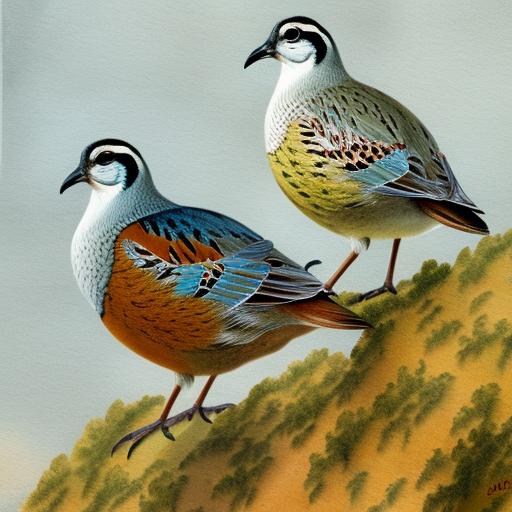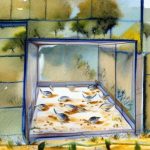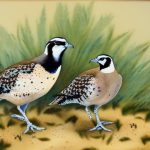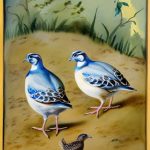California quail, also known as Valley quail, are small, plump birds that are native to the western United States. They are a popular game bird and are also kept as pets due to their attractive appearance and pleasant nature. There are several different breeds of California quail, each with its own unique characteristics and traits. These breeds include the California Valley quail, Gambel’s quail, and the Mountain quail. Each breed has its own distinct coloration and markings, making them a popular choice for bird enthusiasts and hunters alike.
California quail are known for their distinctive plume on their head, which is made up of six feathers that curl forward. They have a round body with a short, curved beak and a small crest on their head. Their plumage is a mix of brown, gray, and white, with intricate patterns that help them blend into their natural habitat. These birds are known for their distinctive call, which sounds like “chi-ca-go,” and can often be heard echoing through the valleys and hills of their native range. Overall, California quail are charming and attractive birds that have become a beloved symbol of the western United States.
Key Takeaways
- California quail breeds are known for their distinctive appearance and unique behaviors, making them popular among bird enthusiasts.
- Physical characteristics of California quail include a plump body, a forward-drooping crest, and a scaly appearance on the belly and breast.
- California quail are primarily found in the western United States, preferring habitats with brushy cover and open areas for foraging.
- These birds are known for their social nature, often forming large coveys and engaging in communal activities such as dust bathing and foraging.
- California quail reproduce through monogamous mating pairs and build shallow ground nests, facing threats from habitat loss and predation.
Physical Characteristics of California Quail
California quail are small birds, measuring around 9-11 inches in length and weighing between 4-6 ounces. They have a plump, round body with a short tail and wings that are adapted for short, rapid flights. Their plumage is a mix of brown, gray, and white, with intricate patterns that help them blend into their natural habitat. The most distinctive feature of the California quail is the plume on their head, which is made up of six feathers that curl forward. This plume is more prominent in males and is often used in courtship displays.
In addition to their plume, California quail have a small crest on their head and a short, curved beak that is well-suited for foraging for seeds and insects. Their legs are short but strong, allowing them to move quickly on the ground and navigate through dense vegetation. Overall, California quail are well-adapted to their natural environment and have physical characteristics that make them well-suited for both survival in the wild and as pets in captivity.
Habitat and Range of California Quail
California quail are found in a variety of habitats throughout the western United States, including open woodlands, brushy areas, and grasslands. They are particularly common in California, where they can be found in both rural and urban areas. These birds prefer areas with dense vegetation for cover and open spaces for foraging, making them well-suited to a wide range of environments. They are also known to inhabit agricultural areas and can often be found in fields and orchards.
California quail have a wide range that extends from southern Oregon to northern Baja California in Mexico. They are also found in parts of Nevada, Utah, and Idaho. Their range has expanded over the years due to human development and the creation of new habitats, making them a common sight in many parts of the western United States. Overall, California quail are adaptable birds that can thrive in a variety of habitats, making them a familiar sight to many people in the western United States.
Behavior and Social Structure of California Quail
California quail are social birds that are often found in small groups called coveys. These coveys can consist of several dozen birds and are typically made up of family groups or individuals that have come together for protection and foraging. Within the covey, there is a strict social hierarchy, with dominant males and females leading the group and younger birds following their lead. This social structure helps the covey stay organized and safe from predators.
California quail are ground-dwelling birds that prefer to walk or run rather than fly. They are known for their quick movements and can often be seen darting through the underbrush in search of food. When threatened, they will often take cover in dense vegetation or run for safety rather than taking flight. They are also known for their distinctive call, which they use to communicate with each other and to warn of potential dangers. Overall, California quail are social and active birds that rely on their group dynamics to survive in the wild.
Reproduction and Nesting Habits of California Quail
California quail breed in the spring and summer months, with males engaging in elaborate courtship displays to attract females. These displays often involve puffing out their chest feathers, calling loudly, and performing a series of dances to impress potential mates. Once a pair has bonded, they will build a nest on the ground, typically hidden in dense vegetation or under shrubs. The female will lay between 12-16 eggs, which she will then incubate for around three weeks until they hatch.
Once the chicks have hatched, they are precocial and able to leave the nest within hours of hatching. They will follow their parents around as they forage for food and learn essential survival skills from them. The family group will stay together until the chicks are old enough to fend for themselves, at which point they will join a covey or strike out on their own. Overall, California quail have fascinating reproductive behaviors that showcase their strong family bonds and intricate courtship rituals.
Conservation Status and Threats to California Quail

California quail are not currently considered to be at risk of extinction, but they do face several threats to their populations. Loss of habitat due to urban development and agriculture is one of the primary threats to these birds, as it reduces the amount of suitable habitat available for nesting and foraging. Additionally, predation by introduced species such as feral cats and foxes can also take a toll on California quail populations.
Conservation efforts are underway to protect California quail and their habitats, including the creation of protected areas and habitat restoration projects. These efforts aim to ensure that these charming birds continue to thrive in the wild for future generations to enjoy. Additionally, responsible hunting practices and regulations help to manage populations and ensure that these birds remain a sustainable resource for hunters. Overall, California quail face several challenges, but with continued conservation efforts, their populations can remain stable for years to come.
Keeping and Caring for California Quail as Pets
California quail can make delightful pets for bird enthusiasts who have the space and resources to care for them properly. When kept as pets, these birds require a spacious aviary with plenty of room to move around and fly short distances. They also need access to dense vegetation or hiding spots where they can take cover when they feel threatened. Additionally, providing a varied diet that includes seeds, insects, and fresh greens is essential for keeping these birds healthy in captivity.
It’s important to note that California quail are social birds that thrive in groups, so it’s best to keep them in pairs or small groups rather than as solitary individuals. Providing enrichment such as perches, dust baths, and toys can help keep these birds mentally stimulated and prevent boredom. It’s also essential to provide regular veterinary care to monitor their health and address any potential issues promptly.
In conclusion, California quail are charming birds with unique physical characteristics and fascinating behaviors that make them a popular choice for both bird enthusiasts and hunters. Their adaptability to a wide range of habitats has allowed them to thrive in the western United States despite facing several threats to their populations. With proper care and conservation efforts, these delightful birds can continue to enchant people for generations to come.
If you’re interested in learning more about California quail breeds, you might also want to check out this informative article on what vegetables do quails eat. It provides valuable insights into the dietary preferences of quails, which can be beneficial for anyone considering raising these beautiful birds.
FAQs
What are the characteristics of California quail breeds?
California quail breeds are small, plump birds with a distinctive teardrop-shaped crest on their heads. They have a brown and gray plumage with a scaly appearance, and the males have a black face and throat with white stripes.
What is the average size of California quail breeds?
California quail breeds are typically around 9-11 inches in length and weigh between 4-6 ounces.
What is the natural habitat of California quail breeds?
California quail breeds are native to the western United States and can be found in a variety of habitats including grasslands, chaparral, and foothills.
What do California quail breeds eat?
California quail breeds primarily feed on seeds, fruits, and insects. They forage on the ground and use their strong beaks to crack open seeds and nuts.
Are California quail breeds good for beginners to raise?
Yes, California quail breeds are relatively easy to raise and are a popular choice for beginners in the world of quail farming. They are hardy birds and can adapt to a variety of environments.
Do California quail breeds require special care?
California quail breeds require a secure and spacious enclosure with plenty of room to forage and dust bathe. They also need protection from predators and access to fresh water and a balanced diet.
Meet Walter, the feathered-friend fanatic of Florida! Nestled in the sunshine state, Walter struts through life with his feathered companions, clucking his way to happiness. With a coop that’s fancier than a five-star hotel, he’s the Don Juan of the chicken world. When he’s not teaching his hens to do the cha-cha, you’ll find him in a heated debate with his prized rooster, Sir Clucks-a-Lot. Walter’s poultry passion is no yolk; he’s the sunny-side-up guy you never knew you needed in your flock of friends!







